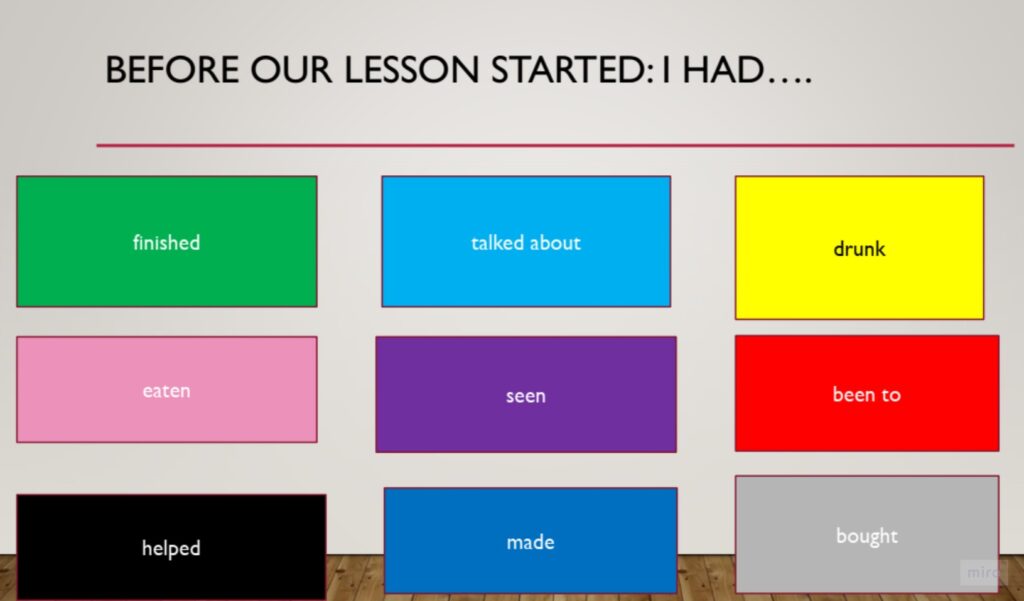
In this post I would like to share a few activities that I came up with for my students that turned to be very effective as regards students’ involvement, the amount of language generated and the opportunities for the target language practice.
All of these are only samples, activities and materials to serve a very specific purpose with a very specific group of students. However, I do believe that they can serve as five case studies that help to create the framework for creation and adaptation of such materials.

#1 You today and you in 2017
This is the activity that we used with my teens, in a freer practice activity focused on comparatives on the B2 level, including simple comparatives, less, as…as and the comparatives quantifiers. The kids were working in pairs, they were answering the question: ‘You today and you in 2017. How different is your life?‘ and they used the wordwall cards to guide them in their discussions.
When I was planning this activity, I prepared 15 cue cards but we barely got through half of them in each pair because the students really wanted to share their experiences and, surprisingly, they did not need any follow-up questions, they were simply talking and talking and talking.

#2 The future us
This activity and the materials were intially created for a group of teens but later I adapted it to the needs of my junior group and to a group of ‘advanced’ primary kids, too in the lessons whose aim was to introduce and to practise ‘will’ and ‘might’ to talk about the future.
Intially, many years ago, when we were still in the classroom I created a handout with all the situations, one per each student in the group because I wanted to do it in the format of a gallery walk. The kids had to move around the room, read the situations and decide who will achieve what. In the end, the students picked up the cards with their names and told of us which of the predictions are most likely to happen in the real life.
Later on this activity had to be adapted to the format of the online classes and I decided to turn it into a simpler speaking activity, again with a set of wordwall cards. The students worked in groups three and they took turns to uncover the cards and to discuss who in the group is most likely to get a new haircut, start wearing glasses, write a book or win an Oscar. They had to justify their answers. During the feedback, we brought back some of their ideas and the students whose names were called out were to comment on these predictions.
Although this is one of the flexible activities (no specific ending, can be stopped at any given point), I abandoned the initially planned timing because the students got really involved into it and I allowed them to go through all the cards. We had a laugh and we produced a lot of language. It is worth mentioning, though, that this activity was done in group that had studied together for a few years and that knew each other very well. This meant that they had enough data in order to be able to make their prediction and, also, there was very little risk that someone will be offended with anyone else’s ideas. Perhaps this kind of an activity would not be a good choice for newly formed groups.

#3 Quiz: How well do we know each other?
I prepared this kind of an activity to practise the target langauge in a personalised way with my primary A1 students and the structure used in this particular game was the combination of ‘How often do you / does X do it?’ and the basic adverbs of frequency (always, often, sometimes, never).
The students were given a set of questions for homework about all the random habits of everyone in the group, such as ‘How often does Sasha play computer games?’. They were supposed to think about them and make their decisions. In class, I was asking the questions and everyone, apart from the student in question was sharing their answers. Afterwards, the student would tell us how often they do it (Sasha: I never play computer games) and sometimes provided some additional information.

#4 Personalised reading
This is a trick (or an activity:-) that I learnt in one of the training sessions about a million years ago (and I do not remember whose it was!) that a text (or a listening task) should be treated in a way that more resembles the real life reading (or listening). That means that we approach the text not to be able to answer all the comprehension questions in the coursebook but to take it very personally. The task is to go through the text, labeling the text with the marks: (+) for all the things that we agree with, (-) for all the things that we do not agree with, (!) for all the things that we find surprising or (?) for all the things that we would like to find out more about and so on and so forth. In the feedback session, students simply compare where they put all the specific marks and discuss why such were their choices. Simple and effective.
There are a few variations of this approach. Students can write their own questions to the text / the listening text and then deal with the text with the focus on these questions. In the feedback session, they share their answers and why they have chosen these particular questions or what their answers would be if the text does not include them, which, actually, is something that happens frequently.
Another way was letting the students decide for themselves which items / parts they want to read and talk about. While we were reading a text on ten different factors to take into consideration while choosing a job (based on Gateway B2, Macmillan). First, the students got only a list and they were asked to choose the five that are most important for them and compare their lists with their friends. Afterwards, they were asked to approach the text, comprising of ten short paragraphs, one per factor, and discuss these. They were instructed to go through all of the items, one by one but they could make decisions as regards the order so that the most important ones were dealt with in the beginning when everyone was at the peak of their focus and involvement. Interestingly enough, some students were choosing to read about the factors that were their priority whereas the others wanted to read more about the factors that they would never take into consideration because they were curious about the other people’s rationale.

#5 The Messy Choir for controlled grammar practice
This is a lovely activity that we are using, with my younger and older kids and sometimes with adults, too. I have already written about it and you can find the original post here.
Today, I would like to share the version of the activity with my B2 teens while we were learning / revising the narrative tenses and the Past Perfect among them. I wanted the students to start using the structure straightaway and in a familiar context. Since the class starts at 18:45, there are plenty of things that everyone would have already done and could talk about.
The boxes with the past participle were appearing one by one and everyone was invited to contribute their sentences, the teacher and the students. Some of the verbs generated more answers, some fewer but, overall, all the students participated and practised the new structured.
We used the same activity in the beginning of a few lessons later on, as a warmer / hello / revision activity.

I hope that you have found something useful here to use with your students or to inspire you to create. I also hope that this post will have its part two. And sooner rather than later!
Happy teaching!